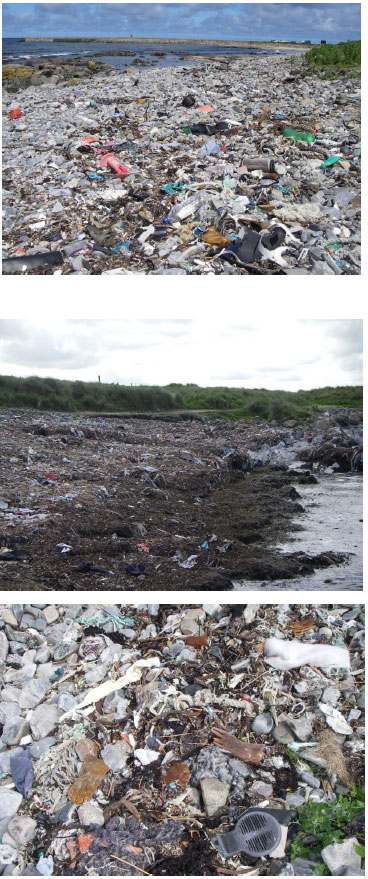Marine litter issues, impacts and actions
A study that will contribute to developing a marine litter strategy for Scotland’s seas in light of the Marine (Scotland) Act 2010.
1. Introduction
1.1 Aims of Scoping Study
This study will contribute to developing a marine litter strategy for Scotland's seas in light of the Marine (Scotland) Act 2010, and the implementation of the EU Marine Strategy Framework Directive ( MSFD). The MSFD is one of the largest and most ambitious attempts at implementing the Ecosystem Approach on an international scale. The MSFD mandates the implementation of the ecosystem approach for all 27 EU member states. The Directive obliges each member state to achieve Good Environmental Status ( GES) within their Exclusive Economic Zone by 2020 for each of eleven environmental descriptors covering various aspects of environmental health. The management of marine litter falls under the MSFD descriptor 10. Targets for each of these descriptors will be set in 2012 and a program of measures to achieve these targets must be put in place in each member state by 2016.
The aim of this scoping study is to explore the issues, types and sources of marine litter, existing marine legislation and initiatives, goals for a new Marine Litter Strategy and recommendations for options to reduce the total litter load. Such information will be essential to address the costs and impacts on the Scottish economy, its marine regions and local communities as well as meeting policy targets within the EU MSFD.
Existing initiatives tend to be based on approaches from elsewhere in the UK and the increase in interest in the state of Scotland's marine environment has led to a growing recognition that these may not be the most effective solutions for Scotland's coast and seas based on our geography, accessibility and population distribution e.g. organising beach clean ups for local residents may be less effective in very remote and sparsely populated coastal areas.
This research will help meet the Scottish Government's strategic objectives including: Wealthier and Fairer - managing the exploitation of Scotland's coastal and marine area; Safer and Stronger - ensuring that local coastal communities have the opportunity to manage local coasts and seas to improve opportunities and enhance quality of life; Greener - developing new tools to manage and direct exploitation to ensure Scotland's assets are used sustainably.
1.2 Marine Litter Definition
The international definition of marine litter, as defined by the United Nations Environment Program is "any persistent, manufactured or processed solid material discarded, disposed of or abandoned in the marine and coastal environment. Marine litter consists of items that have been made or used by people and deliberately discarded into the sea or rivers or on beaches; brought indirectly to the sea with rivers, sewage, storm water or winds; accidentally lost, including material lost at sea in bad weather (fishing gear, cargo); or deliberately left by people on beaches and shores" ( UNEP, 2005).
1.3 Historical and Global Context
The disposal of waste at sea is not a new concept, but the ongoing shift towards more durable materials including synthetics, has resulted in a rapid increase in residence time. The slow decomposition rate of these materials within the marine environment has overall resulted in a litter sink with a net accumulation.
Oceanic currents transport buoyant litter items (often plastics) across territorial boundaries, accumulating around oceanic eddies and sheltered coastlines and because the sources of litter are diffuse, the resulting impacts and removal responsibility currently lie outside the control of any one agency or body.
It should not be assumed, however, that the majority of litter originates from overseas sources; the current lack of baseline data and overall understanding of the sources and interactions litter has with the marine environment and its impacts on society further exacerbates organisational problems aimed at tackling the issue.
1.4 Marine Litter in Scotland
The problem of marine litter also extends to Scotland. As in the global context, marine litter in Scotland comes from a number of different sources; both land and sea and poses a number of problems across the economy, environment and society. These detrimental effects include ingestion and entanglement of wildlife as well as wider ecosystem deterioration, public health issues and impacts on aesthetics and non use values and a wide range of economic impacts across the raft of industries reliant on our coastal and marine environment. In addition, there are legislative requirements and obligations including MSFD compliance, which must be taken into account.
It is difficult to predict future trends and new sources of marine litter, though it is widely recognised that due to the nature of the marine environment in Scotland, current loads will not degrade and reduce and any future inputs will add to that, will an overall net accumulation of litter in our seas and ultimately an increase in the impacts associated with it.
These issues are complex, stem from a number of sources and are complicated by the nature of the marine environment and the geography and demographics of Scotland. Each and every part of our coast and seas is affected by marine litter, often in low levels, but with some areas accumulating higher levels in litter sinks (figure 1-1). Each of these individual factors needs to be taken into consideration and suitable management solutions derived to provide an integrated approach to its overall management.

1‑1 Litter accumulations along the Aberdeenshire coastline
Contact
There is a problem
Thanks for your feedback